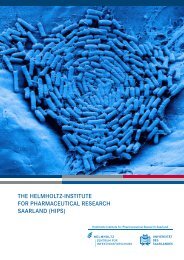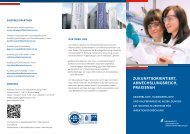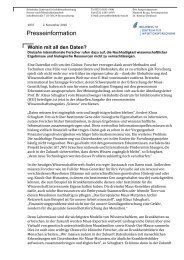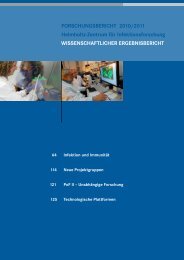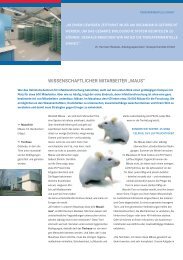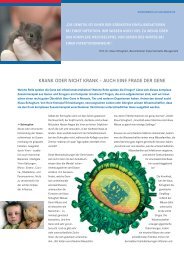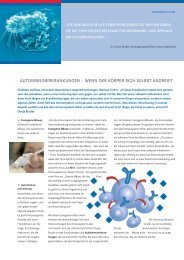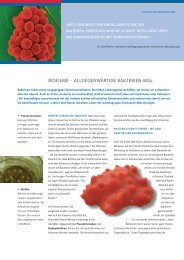Research Report 2010 2011 - Helmholtz-Zentrum für ...
Research Report 2010 2011 - Helmholtz-Zentrum für ...
Research Report 2010 2011 - Helmholtz-Zentrum für ...
Create successful ePaper yourself
Turn your PDF publications into a flip-book with our unique Google optimized e-Paper software.
SCIENTIFIC REPORTS | Infection and Immunity | Strategies for Prevention and Therapy 105<br />
04.4 Chronic Infection and Cancer<br />
PROJECT LEADER | Prof. Dr. Lars Zender | Junior <strong>Research</strong> Group Chronic Infection and Cancer |<br />
lze08@helmholtz-hzi.de<br />
PROJECT MEMBERS | Dr. Tae-Won Kang | Dr. Michelle Stange | Dr. Torsten Wüstefeld | Dr. Tetyana Yevsa |<br />
Daniel Dauch | Florian Heinzmann | Lisa Hönicke | Anja Hohmeyer | Nils Jedicke | Marina Pesic | Ramona Rudalska<br />
Liver Cancer (Hepatocellular Carcinoma) represents one<br />
of the most frequent and most deadly cancers worldwide.<br />
The incidence of the disease is increasing, with more than<br />
700,000 new cases per year, 50,000 of which occur in<br />
Europe.<br />
We are taking functional genomic approaches to study<br />
molecular mechanisms of liver damage, liver regeneration<br />
and liver cancer. As our major tool, we are harnessing the<br />
naturally occurring process of RNA interference (RNAi).<br />
Over the past couple of years we have developed and refined<br />
microRNA based shRNA technology, which allows stable<br />
or reversible RNAi-mediated inhibition of any endogenous<br />
gene in cultured cells or in mouse models of liver regeneration<br />
and liver cancer. The use of inducible RNAi allows us<br />
to interfere with gene products within regenerating livers<br />
or growing tumours in mice, either at a single gene level or<br />
through pooled multi-gene screening. Genome-scale retroand<br />
lentiviral shRNA libraries targeting the murine and<br />
the human genome are used to conduct screens in order to<br />
identify new therapeutic targets in regenerative medicine<br />
and hepatobiliary oncology.<br />
1. Translational Regenerative medicine and targeting<br />
of liver stem cells The liver has tremendous potential<br />
to regenerate following tissue damage caused by toxins<br />
or infection. It is unique that differentiated hepatocytes,<br />
which normally reside in the Go phase of the cell cycle, can<br />
re-enter the cell cycle subsequent to liver damage and give<br />
rise to new hepatocytes. However, when chronic liver damage<br />
occurs, there is an exhaustion of the regenerative capacity<br />
of hepatocytes and only partial compensation by a stem<br />
cell compartment. The consequence is chronic liver failure,<br />
which represents a major health problem worldwide.<br />
We have established a unique system which allows conducting<br />
in vivo RNAi screens to identify positive and negative<br />
regulators of hepatocyte proliferation during chronic liver<br />
damage. A recently completed in vivo RNAi screen identified<br />
a dual specificity protein kinase as a promising therapeutic<br />
target for hepatic regenerative medicine. Functional<br />
characterization showed that knockdown of the target by<br />
different shRNAs led to a more than 1000-fold increased<br />
proliferative capacity of hepatocytes in a mouse model of<br />
chronic liver damage and greatly improved survival. We<br />
are currently working to translate the obtained genetic<br />
information into new pharmacological strategies for hepatic<br />
regenerative medicine.<br />
2. Translational Oncology, mosaic cancer mouse modeling,<br />
in vivo RNAi, identification of new, innovative<br />
therapeutic targets in liver cancer Tumour genetics can<br />
guide the application of particular therapeutic strategies<br />
and can predict treatment outcome. By combining in vivo<br />
RNAi technology with powerful mosaic liver cancer mouse<br />
models, we have made substantial progress in pinpointing<br />
new cancer genes and tumour suppressor networks in hepatocellular<br />
carcinoma (HCC). In addition to probing tumour<br />
suppressor genes in vivo one at a time, we also performed<br />
in vivo screens to multiplex this approach. We recently performed<br />
the first in vivo RNAi screen, which identified more<br />
than ten new tumour suppressor genes in HCC.<br />
Current projects in the laboratory are aiming to identify<br />
genetic vulnerabilities in hepatobiliary malignancies. These<br />
approaches are based on the concept of “synthetic lethality”,<br />
which assumes that by virtue of their accumulated genetic<br />
alterations, tumour cells may acquire vulnerabilities that<br />
create opportunities for new therapeutic interventions.<br />
Several high confidence targets have been identified and we<br />
are currently trying to translate these into new treatment<br />
strategies.<br />
Dr. Torsten Wüstefeld (le) und Florian Heinzmann (ri) discussing<br />
results from an experiment. On the left side: Dr. Tetyana<br />
Yevsa, on the right side: Ramona Rudalska. Photo: HZI<br />
Zender, L., Xue, W., Zuber, J., Semighini, C.P., Krasnitz, A., Ma, B., Zender, P., Kubicka, S.,<br />
Luk, J.M., Schirmacher, P., McCombie, W.R., Wigler, M., Hicks, J., Hannon, G.J., Powers,<br />
S. & Lowe, S.W. (2008) An oncogenomics-based in vivo RNAi screen identifies tumor<br />
suppressors in liver cancer. Cell 135(5), 852-64.<br />
Xue, W., Zender, L., Miething, C., Dickins, R.A., Hernando, E., Krizhanovsky, V.,<br />
Cordon-Cardo, C. & Lowe, S.W. (2007) Senescence and tumour clearance is triggered by<br />
p53 restoration in murine liver carcinomas. Nature 445(7128), 656-60.<br />
Zender, L., Spector, M.S., Xue, W., Flemming, P., Cordon-Cardo, C., Silke, J., Fan, S.T.,<br />
Luk, J.M., Wigler, M., Hannon, G.J., Mu, D., Lucito, R., Powers, S. & Lowe, S.W. (2007)<br />
Identification and validation of oncogenes in liver cancer using an integrative oncogenomic<br />
approach. Cell 125(7), 1253-67.



